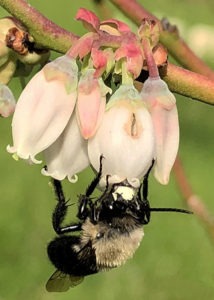
The southeastern blueberry bee (Habropoda laboriosa) is a native bee found in much of the eastern U.S. It is approximately a half inch long and looks kind of like a small bumble bee. Like its name suggests, the southeastern blueberry bee forages primarily on blueberry pollen and nectar, although it will also visit several other early blooming plants.
Southeastern blueberry bees are solitary nesters that dig nesting chambers in sandy soils. Sometimes several female blueberry bees will create nesting chambers close to each other, but each bee digs and uses her own nesting chamber. Think of it as a bee subdivision where each bee has her own “house.” Each nesting chamber can contain several rooms and each room will contain a single egg along with the nectar and pollen that the larvae will need to consume when it hatches.
Most of a southeastern blueberry bee’s life is spent underground as either a larvae or a pupae. The adult southeastern blueberry bees emerge from their underground nests in the early spring, about the time the blueberries start to bloom. The adult bees are only active for a few weeks during which time they must mate, dig nesting chambers, lay eggs, and store enough pollen and nectar to last each larvae until it matures and emerges the following spring. After a few weeks of activity, the adults die and southeastern blueberry bees won’t be seen again until this year’s young emerge next spring. With so much of its life occurring underground, it is easy to see how local populations could be unintentionally exterminated without anyone even realizing they were there.
Although the lifespan of an adult southeastern blueberry bee is short, it plays a very important role in the ecosystem. Both native, wild blueberries and domesticated, commercial blueberries are more efficiently pollinated through a process called “buzz pollination.” In buzz pollination, the bee crawls inside the flower and rapidly vibrates its shoulders to loosen the pollen. Southeastern blueberry bees and a few other native bees do this; honey bees don’t. Researchers have estimated that it takes three visits from a honey bee to pollinate a blueberry flower as well as one visit from a native bee that uses buzz pollination. Only in recent years have we begun to realize how important native bees are to crop pollination and the vital roles they play in our ecosystems.

This article was part of Shannon’s original Kentucky Pollinators and Backyard Wildlife blog which evolved into the blog for Backyard Ecology.

Backyard Ecology: Exploring Nature in Your Backyard
Nature isn’t just “out there.” It’s all around us, including right outside our doors. Hi, my name is Shannon Trimboli, and I am the host of Backyard Ecology. I live in southcentral Kentucky and am a wildlife biologist, educator, author, beekeeper, and owner of a nursery specializing in plants for pollinators and wildlife conservation. I invite you to join me as we ignite our curiosity and natural wonder, explore our yards and communities, and improve our local pollinator and wildlife habitat. Learn more or subscribe to my email list at www.backyardecology.net.

Leave a Reply